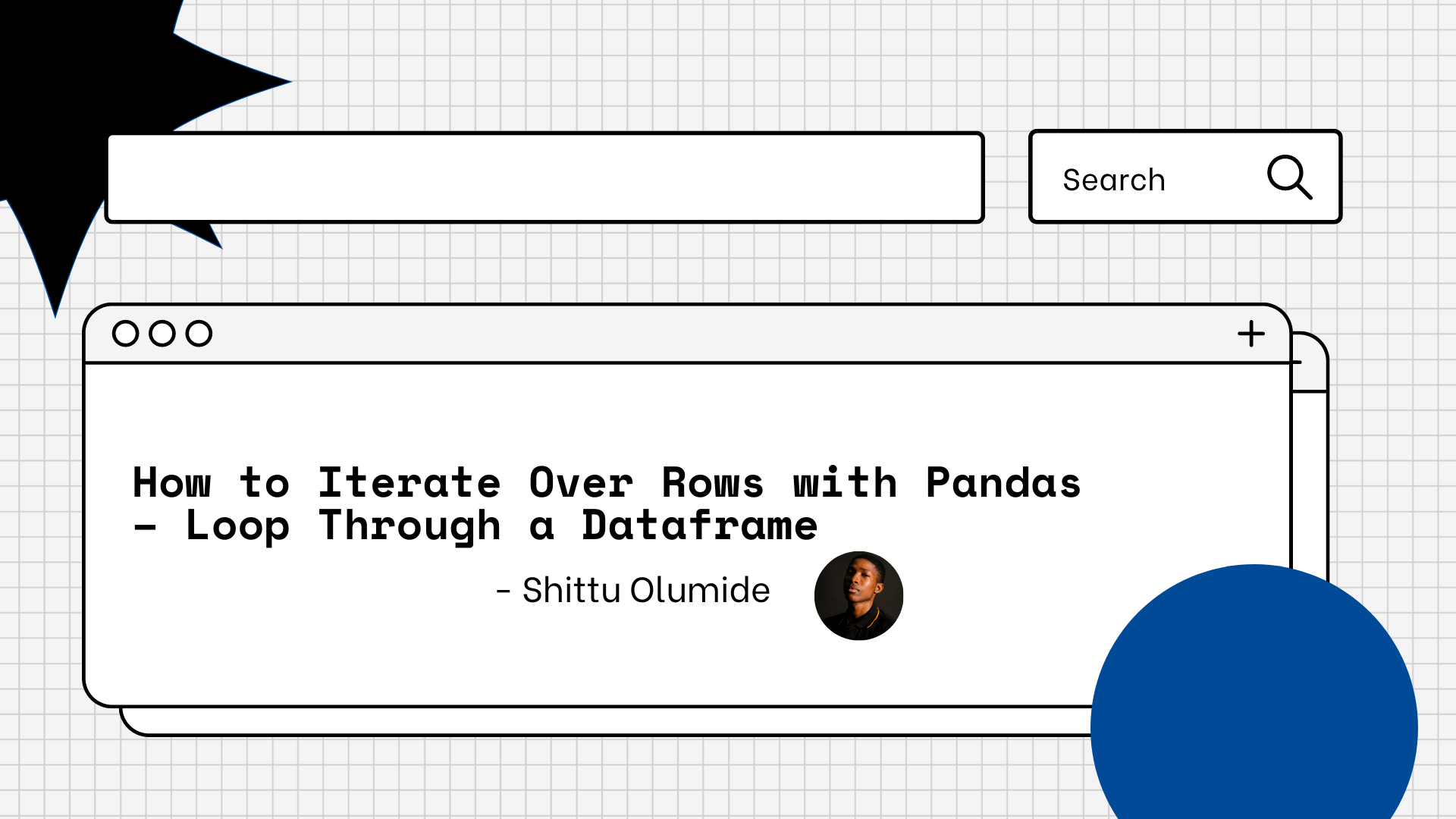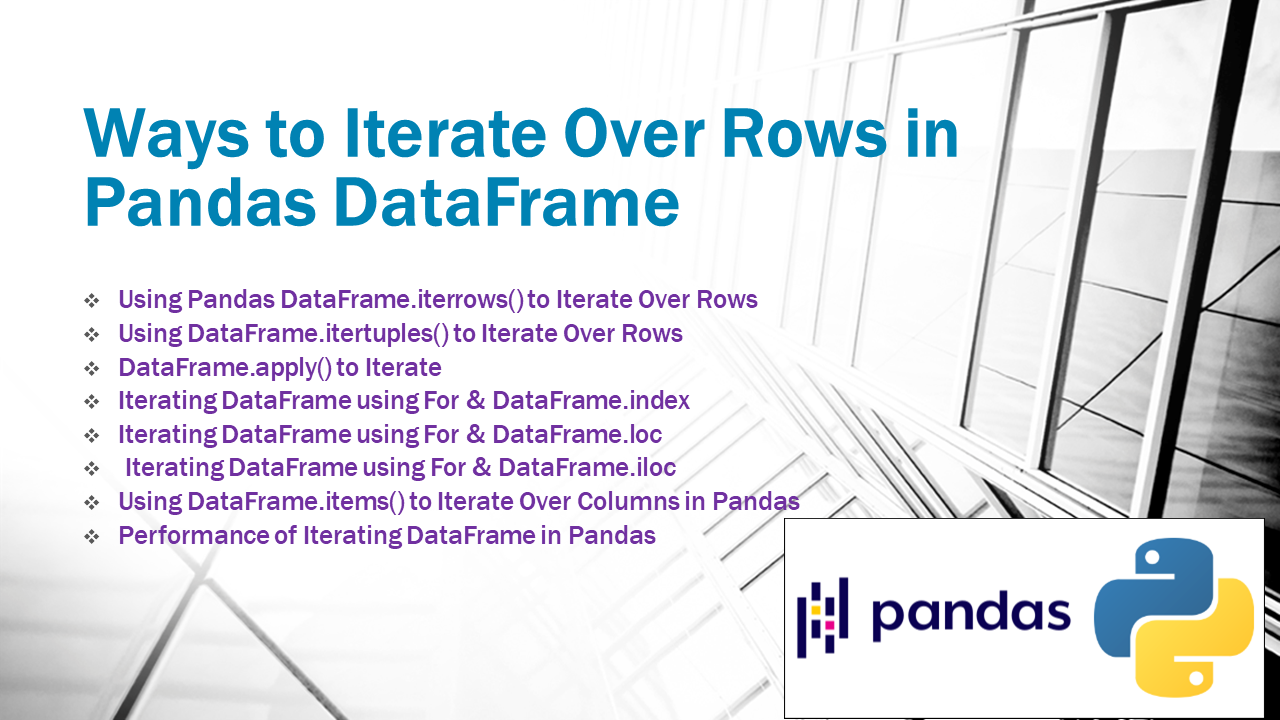Iterate Pandas DataFrame Rows in Python
Learn various efficient methods to loop through rows in a Pandas DataFrame using Python, from basic iteration to advanced techniques for improved performance.
Learn various efficient methods to loop through rows in a Pandas DataFrame using Python, from basic iteration to advanced techniques for improved performance.
In the realm of data manipulation with Pandas, a fundamental principle governs efficiency: prioritize vectorized operations over row-by-row iteration. While Pandas DataFrames offer methods for iteration, they often prove computationally expensive compared to the inherent strength of Pandas in handling vectorized operations. This article delves into the scenarios where iteration might be necessary, outlining the methods available while emphasizing their relative efficiency. Furthermore, it elucidates the reasons behind the performance disparity between iteration and vectorization, advocating for alternative approaches that leverage the true power of Pandas. Through illustrative examples, the article guides you towards harnessing the efficiency of vectorized operations, boolean indexing, and other Pandas techniques, enabling you to write cleaner, faster, and more Pythonic code.
Pandas DataFrames are not designed for row-by-row iteration. While you can iterate, it's often inefficient. Pandas excels at vectorized operations that work on entire columns or DataFrames at once.
When iteration is necessary, here's how to do it and why it's usually not the best approach:
iterrows()
This is the most straightforward method but often the slowest.
It treats each row as a Series, which can introduce overhead.
import pandas as pd
data = {'col1': [1, 2], 'col2': [3, 4]}
df = pd.DataFrame(data)
for index, row in df.iterrows():
print(index, row['col1'], row['col2'])itertuples()
Faster than iterrows() because it represents rows as named tuples.
Still slower than vectorized operations.
for row in df.itertuples():
print(row.Index, row.col1, row.col2) Apply Function (for applying a function to each row)
Can be faster than iterrows() and itertuples() for applying custom functions.
def my_function(row):
return row['col1'] * 2
df['new_col'] = df.apply(my_function, axis=1)Why is iterating over rows often inefficient?
Alternatives to Iteration:
apply(), map(), applymap(), and NumPy functions for element-wise operations.Example of Vectorization:
# Instead of:
for index, row in df.iterrows():
if row['col1'] > 1:
df.loc[index, 'col2'] = row['col1'] * 10
# Use:
df['col2'] = df['col1'].where(df['col1'] <= 1, df['col1'] * 10)In summary:
itertuples() or apply functions for potentially better performance.This Python code demonstrates different ways to iterate through a Pandas DataFrame and manipulate its data. It shows how to use iterrows(), itertuples(), and the apply() function for row-wise operations. Additionally, it highlights the performance difference between modifying a DataFrame within a loop (inefficient) and using vectorized operations like where() (efficient) for the same task. The code provides a clear example of how vectorization can significantly improve code speed and readability in Pandas.
import pandas as pd
# Sample DataFrame
data = {'col1': [1, 2, 3, 4, 5],
'col2': [10, 20, 30, 40, 50]}
df = pd.DataFrame(data)
# ----------------------------------
# 1. Iteration using iterrows()
# ----------------------------------
print("Using iterrows():")
for index, row in df.iterrows():
print(f"Index: {index}, Col1: {row['col1']}, Col2: {row['col2']}")
# ----------------------------------
# 2. Iteration using itertuples()
# ----------------------------------
print("\nUsing itertuples():")
for row in df.itertuples():
print(f"Index: {row.Index}, Col1: {row.col1}, Col2: {row.col2}")
# ----------------------------------
# 3. Apply function to each row
# ----------------------------------
def multiply_by_2(row):
return row['col1'] * 2
df['col3'] = df.apply(multiply_by_2, axis=1)
print("\nDataFrame after applying function:")
print(df)
# ----------------------------------
# Inefficient Iteration Example
# ----------------------------------
# Multiply 'col2' by 10 where 'col1' is greater than 2
for index, row in df.iterrows():
if row['col1'] > 2:
df.loc[index, 'col2'] = row['col2'] * 10
print("\nDataFrame after inefficient iteration:")
print(df)
# ----------------------------------
# Efficient Vectorized Operation
# ----------------------------------
# Achieve the same result using vectorization
df['col2'] = df['col2'].where(df['col1'] <= 2, df['col2'] * 10)
print("\nDataFrame after vectorized operation:")
print(df)Explanation:
iterrows() and itertuples(): The code demonstrates how to loop through rows using both methods. You can see how itertuples() provides a cleaner way to access column values using named attributes.apply() function: The multiply_by_2 function is applied to each row, creating a new column 'col3' with the results.where() (efficient) to achieve the same outcome.This example emphasizes how vectorized operations in Pandas are significantly faster and more concise than row-by-row iteration, especially when dealing with larger datasets.
apply(), the axis=1 argument is crucial for row-wise operations. axis=0 (the default) applies the function column-wise.for chunk in pd.read_csv('data.csv', chunksize=1000): .... This can prevent memory issues.cProfile) to identify if iteration is truly the source of slow performance in your code.groupby(), rolling(), pivot_table()) that can often replace the need for iteration entirely.Key takeaway: While iteration is possible in Pandas, it should be your last resort. Embrace vectorization and the wealth of Pandas functionality to write efficient and elegant data manipulation code.
This article emphasizes that iterating over Pandas DataFrames row-by-row is inefficient and should be avoided whenever possible. Pandas shines with vectorized operations that process entire columns or DataFrames at once, leveraging NumPy's speed.
Here's a breakdown:
Iteration Methods (least to most efficient):
iterrows(): Simple but slowest, returns each row as a Series.itertuples(): Faster, represents rows as named tuples.Why Iteration is Slow:
Alternatives to Iteration:
apply(), map(), applymap(), and NumPy functions for element-wise operations.Key Takeaway:
In conclusion, while iteration is possible in Pandas DataFrames, it's generally inefficient and should be avoided unless absolutely necessary. Pandas excels at vectorized operations that work on entire columns or DataFrames at once, leveraging the underlying efficiency of NumPy. When you need to perform operations on rows, prioritize vectorized operations using Pandas functions like apply(), map(), applymap(), and NumPy functions. Boolean indexing is another powerful technique to filter rows based on conditions without resorting to explicit loops. If you must iterate, consider itertuples() or apply functions for potentially better performance. Remember, mastering vectorization and other Pandas techniques is key to writing efficient and elegant data manipulation code.
 Different ways to iterate over rows in Pandas Dataframe ... | A Computer Science portal for geeks. It contains well written, well thought and well explained computer science and programming articles, quizzes and practice/competitive programming/company interview Questions.
Different ways to iterate over rows in Pandas Dataframe ... | A Computer Science portal for geeks. It contains well written, well thought and well explained computer science and programming articles, quizzes and practice/competitive programming/company interview Questions. How to Iterate Over Rows with Pandas – Loop Through a Dataframe | By Shittu Olumide This article provides a comprehensive guide on how to loop through a Pandas DataFrame in Python. I'll start by introducing the Pandas library and DataFrame data structure. I'll explain the essential characteristics of Pandas, how t...
How to Iterate Over Rows with Pandas – Loop Through a Dataframe | By Shittu Olumide This article provides a comprehensive guide on how to loop through a Pandas DataFrame in Python. I'll start by introducing the Pandas library and DataFrame data structure. I'll explain the essential characteristics of Pandas, how t... pandas.DataFrame.iterrows — pandas 2.2.3 documentation | Iterate over DataFrame rows as (index, Series) pairs. Yields: indexlabel or tuple of label. The index of the row. A tuple for a ...
pandas.DataFrame.iterrows — pandas 2.2.3 documentation | Iterate over DataFrame rows as (index, Series) pairs. Yields: indexlabel or tuple of label. The index of the row. A tuple for a ... Iterating over row in a DataFrame - New to Julia - Julia Programming ... | Hello, I wish I could implement one of my Python models on Julia, but have been stuck for hours on the basic iteration problem in the context of the Julia language. Basically, I just want to iterate over each row of my DataFrame #Step 1: declaration of endogenous variables columnnames = ["A","B"] T = 100 columns = [Symbol(col) => zeros(T) for col in columnnames] y = DataFrame(columns...) #I am launching my iteration for t in 1:T if t == 0 #Step 2: Initial values are assigned ...
Iterating over row in a DataFrame - New to Julia - Julia Programming ... | Hello, I wish I could implement one of my Python models on Julia, but have been stuck for hours on the basic iteration problem in the context of the Julia language. Basically, I just want to iterate over each row of my DataFrame #Step 1: declaration of endogenous variables columnnames = ["A","B"] T = 100 columns = [Symbol(col) => zeros(T) for col in columnnames] y = DataFrame(columns...) #I am launching my iteration for t in 1:T if t == 0 #Step 2: Initial values are assigned ... Pandas Iterate Over Rows with Examples - Spark By {Examples} | Like any other data structure, Pandas DataFrame also has a way to iterate (loop through row by row) over rows and access columns/elements of each row.
Pandas Iterate Over Rows with Examples - Spark By {Examples} | Like any other data structure, Pandas DataFrame also has a way to iterate (loop through row by row) over rows and access columns/elements of each row. Efficiently iterating over rows in a Pandas DataFrame | by Maxime ... | Never use iterrows and itertuples again
Efficiently iterating over rows in a Pandas DataFrame | by Maxime ... | Never use iterrows and itertuples again